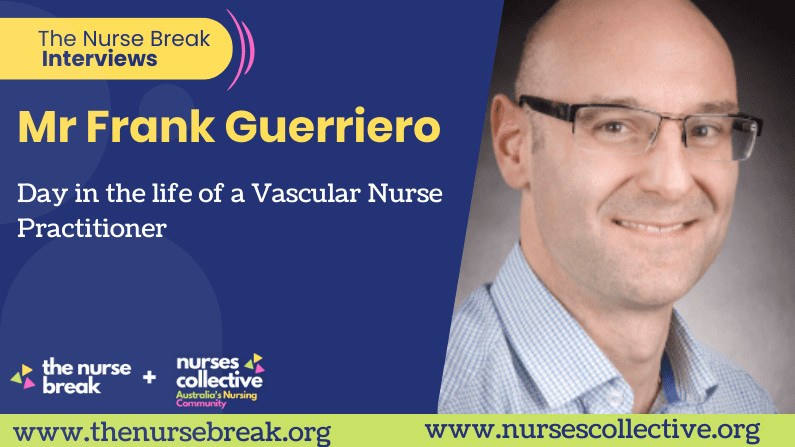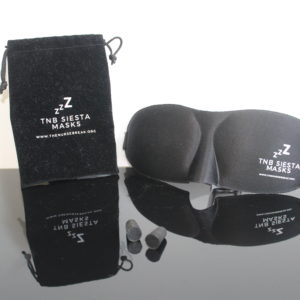Table of Contents
We are excited to interview Frank Guerriero about a Day in the life of a Vascular Nurse Practitioner. Frank is a respected Nurse Practitioner currently working with the Department of Vascular and Endovascular Surgery based at Flinders Medical Centre; a role which entails both clinical and research activities.
Frank is the current President of the Australian and New Zealand Society for Vascular Nursing, a committee member of the South Australian Society for Vascular Nursing and past president of the South Australian Wound Management Association (SAWMA), now Wounds Australia. He also holds a long history of teaching and education, as a Clinical Lecturer for several of Adelaide’s tertiary universities.
Read more articles from nurses like Frank here
Submit an expression of interest to write an article for us or suggest someone we should interview next
Join our Free Australian Nursing Community:
- Nursing Students, Nurses, NPs, Nurse Academics, Researchers, and Educators: Register at www.nursescollective.org Connect with like-minded nurses across Australia. Nurses Collective is used by the Australian College of Nurse Practitioners for its members across Australia.
Introduction
Hello, my name is Frank, I’ve been nursing now for over 26 years and am currently employed as a Nurse Practitioner in the speciality of Vascular Surgery with the Department of Vascular and Endovascular Surgery at Flinders Medical Centre, South Australia.
Throughout my nursing career, I have worked only in tertiary hospitals and spent my early career working in general medicine, infectious diseases, respiratory, intensive care, hyperbaric medicine and outpatients.
It was during my time in hyperbaric that I developed my love for wound management and tissue viability. When away from work I am an avid gamer (both video and boardgames) and keep myself fit through the martial art Aikido.
Day in the life of a Vascular Nurse Practitioner
My day typically starts with attending ward round – where I serve as a primary advisor for complex wound management of vascular related wounds (oedema disorders/venous wounds and diabetic foot wounds or surgical complications), the role also serves as link between the community and tertiary hospital, so will often be called upon to assist with discharge planning.
Attending ward round also serves as a ‘familiarisation’ with the current active patient cohort, so you get to know the patients being cared for in your service. Following ward round time will be divided between attending outpatient clinics (currently one full day and two half days a week) where I work alongside junior medical officers – to support their development of the management of vascular disease related wounds and serving as an adjunct to the vascular surgeons.
When not in clinics the role is frequently required to support management of patients outlying the vascular ward, responding to phone calls from community nurses and general practitioners who are typically seeking advice about vascular wound management or escalating care of patients known to our service.
Any remaining spare time is spent on documentation and administrative duties such as writing and revision of protocols, quality improvement and progress of research projects.
(phew it sounds like quite a bit when you take a moment to spell it out!)
The Nurse Practitioner Role
Many people may not fully understand the role of a Nurse Practitioner. Could you clarify the key responsibilities and contributions of Nurse Practitioners in the field of vascular nursing and healthcare in general?
In Australia a Nurse Practitioner (NP) is a legally protected title, only registered nurses who have been endorsed by the Australian Health Professionals Regulation Agency (AHPRA) are allowed to use the title. An NP is someone who has undertaken additional studies and is endorsed to practise in an extended scope.
An extended scope of practice allows the NP to undertake tasks traditionally reserved for medical officers such as prescription of medications, performing of minor procedures and initiation of radiological and laboratory based tests such as blood tests and x-rays.
The NP role has evolved in response to addressing the gap between medical specialisation and advanced nursing practice. NP’s are able to practise autonomously – meaning they do not need direct medical supervision to make decisions about patient care, which includes initiation of therapy. To date there are around 2200 endorsed NP’s in Australia who work across most speciality and general fields.
In context of vascular nursing – my role has tended to focus on complex wound management as this has been a long standing passion of mine. This includes the initiation of tests such as ankle brachial pressure indices, which tests for arterial disease and the health of a patients blood supply, x-rays to look for bone disease in the feet of people living with diabetes, blood tests and wound swabs.
In more recent times my scope of practice has also included the performing of minor surgical procedures such as sharp wound debridement and wound biopsies and performing of epidermal skin grafts. All of these skills contribute significantly to the work of the vascular surgical team and greatly expedite diagnosis and treatment of these patients as they do not have to wait for a vascular surgeon review.
Patient Care and Case Management
As a Nurse Practitioner, you’re involved in patient case management. Can you explain how you manage complex cases, especially in the context of vascular surgery?
Case management involves first uncovering the underlying cause for a patient’s presenting illness (aetiology). Understanding what drives the problem is vital to coming up with a suitable and effective solution. So this means I like to get to know people who are referred to my clinic, their background, their health problems to date and what bothers them most about their condition. From there we can then perform any tests we may need to determine how healthy their vascular system is.
Vascular Disease
There are two key aspects to vascular disease – namely venous disease and peripheral arterial disease. Both states of disease result in poor health of the lower limbs, but do so in different ways.
Peripheral arterial disease – Arteries are the vessels which supply blood to tissues from your heart. Damage to blood vessels or blockages results in insufficient supply of nutrients, oxygen and immune cells to the bodies tissues, which will impair wound healing.
Venous disease – Veins are the vessels which drain blood away from the tissues and return it to your heart and lungs for ‘recharging’. Venous disease typically involves issues with effective drainage of blood out of the lower limbs and results in a build of fluids (oedema) and the toxic wastes that need to be removed and recharged from the body.
Excessive fluid and stagnation of wastes can result in poor wound healing in the lower leg and is also related to poor skin health as well.
Treatment of these diseases can be achieved through a combination of vascular surgery (removal of arterial blockages or removal of dysfunctional veins) and contemporary wound management, which will include compression therapy and debridement of wound tissue.
My role involves closely working with the vascular surgeons, podiatrists, dieticians and other medical specialities to ensure that all aspects of a patient’s vascular disease are treated.
Vascular Nursing Specialisation
Vascular Nursing involves working with patients who are living with vascular diseases. Vascular disease is essentially any disease of the circulatory (vascular) system – so essentially any artery or vein extending from the aortic arch to the peripheries (think fingertips and toes!).
Vascular nursing is considered a subspecialty of surgical nursing, as the majority of conditions are addressed with surgical procedures. The most common conditions include peripheral arterial and venous disease, lower limb ischemia, abdominal aortic aneurysm, any arterial aneurysms, carotid artery disease and diabetic foot disease.
The procedures used to treat these diseases include: lower limb arterial bypasses, endovascular arterial and venous procedures also known as angiograms or venograms, vein ablations or varicose vein removal, abdominal aortic repair or bypass and minor and major lower limb amputations.
A vascular nurse will be involved with the post-operative and rehabilitation of a patient who has undergone surgery or who is suffering from one of these diseases and whose condition has deteriorated to the point of needing inpatient care. The types of skills a vascular nurse will need to develop include post-operative patient care, wound management and compression bandaging.
A working knowledge of the procedures commonly used in vascular surgery will greatly enhance a nurse’s ability to predict any problems that may arise in a patient’s journey post vascular surgery.
Wound Management
I think there has been a long standing perception that wound management is the art of selecting dressings. Whilst dressing selection is certainly important, the discipline of wound management encompasses more than knowing which dressing for what wound. Having a working knowledge of the underlying causes of wounds and knowing how to manage those underlying conditions is pivotal to reaching a level of expertise in wound management.
You can throw a lot of expensive dressing products at a wound and not see results if you don’t address the underlying cause. Working alongside vascular surgeons has certainly strengthened my understanding of wound healing and enabled me to provide comprehensive treatment plans to patients suffering from chronic and complex wounds.
Getting off my soap box, In the almost two-decades of practising wound management I have seen quite a few developments in the space. One of the biggest changes has been the rise of topical antimicrobial and wound modulating dressings. These are dressings that contain chemicals or additives that target specific problems in the wound bed.
Some examples include: dressings which host a chemical which mitigates protease activity in chronic wounds such as venous leg ulcers or chronic diabetic foot wounds. Another example would be the inclusion of a chelating agent in a silver dressing to help address chronic bacterial colonies known as biofilms.
The chelating agent targets the protein shields of these bacterial biofilms to break them open and make the bacteria hiding inside more susceptible to the silver ions which kill them.
One of the most promising technologies was a device which let you harvest the epidermal layer of skin, via negative pressure suction and heat, which would form blisters which you could take the tops off and transfer them to a wound via an adhesive dressing.
This technology does not require a theatre or anaesthetic to use and was perfect as an advanced practice nurse-led treatment. Known as a Cellutome, this epidermal harvest and graft device was sadly removed from the market by its manufacturer – 3M – due to poor market uptake.
Literally the month after I published a case series on the use of this technology it was pulled from the market – I’m still sore about this. I’m currently looking for an alternative epidermal device to replace this loss in my practice.
Venous Insufficiency Management
As mentioned above venous insufficiency is a disease that results in poor drainage of venous blood from the lower legs arising from damage to the structures of the vein – which ultimately results in hypertension of the venous system.
Venous hypertension results in insufficiency of this system in turn resulting in distension of the veins walls and leaking of blood and fluids out into the surrounding tissues – think of a river bursting its banks. This leads to swollen legs, skin changes – such as haemosiderin staining, varicose veins and ulcers.
There are a lot of factors that can contribute to venous disease, and treating venous disease of the leg. Many of these factors involve modifications to lifestyle, which the vascular NP role can advise, direct and encourage patients to help manage this condition.
Some examples include – poor calf muscle pump activity – the calf muscle is the ‘heart of the lower leg’ it is a key contributor to the ejection of blood and lymph from the lower leg. Injuries that impair calf muscle use, occupations that involve standing for long periods of time or gait changes related to ageing can all contribute to venous insufficiency.
This can be addressed by showing patients exercises to enhance their calf muscles, by encouraging them to raise their legs when at rest to help with venous draining or referring a patient on to a physiotherapist to learn some exercises to encourage calf muscle pump.
Of course you can’t talk about venous insufficiency without talking about compression therapy! Compression therapy involves the application of external pressure to the lower leg to facilitate enhanced venous return and a reduction of oedema.
This is facilitated through the use of external elastic force to compress the skin and underlying tissues, using either elastic bandaging systems or elastic garments such as stockings. When you scratch the surface there is a hefty body of knowledge behind prescribing the right kind of compression for patients – much like wound management it entails a deeper understanding of the underlying causes of venous disease.
For those wanting to start enhancing their knowledge on compression therapy I strongly recommend reading the S.T.R.I.D.E guidelines – https://lymphoedemaeducation.com.au/wp-content/uploads/2019/07/S.T.R.I.D.E.-Professional-Guide-to-Compression-Garment-Selection-for-the-Lower-Extremity.pdf
Whilst focused on lymphoedema (a disease we also treat with compression therapy) they very much relate to venous insufficiency and are an excellent resource.
Path to Becoming a Nurse Practitioner
My journey to becoming an NP started with a dream to implement the Wound Management Nurse Practitioner role at my first tertiary hospital. On a verbal promise with a nursing director I was encouraged to go study a masters program, get my qualifications and then come back and speak to them. This was back in 2006, prior to Nurse Practitioner Candidates or a formal NP career pathway being established in South Australia.
I finished my Master of Nursing Science Nurse Practitioner in 2008 and returned to the same nursing director to be told there was no funding for such a role and that I would need to submit a business case to make this happen.
I received little support from the hospital executive to make this happen, and after a couple of years of submitting business cases that went nowhere I became quite disillusioned with the process and health care bureaucracy.
Back in the early 2000’s to become endorsed as a practising NP you had to have support from a health service or a medical officer and be in a role that would transition to an NP (essentially an advanced practice nursing role – what we called Clinical Practice Consultants back then or what are known as Nurse Consultants now). As I was only a level 2 clinical nurse working in hyperbaric I had no easy path to transition to an NP.
In a weird stroke of luck – in 2010 the South Australian Nurses Board was winding up to become part of AHPRA and in acknowledgement of the nurses who were not yet endorsed as NP’s but who had undertaken the study to become one, they lifted several of the conditions to endorsement – thus allowing myself and about 9-10 other nurses who were in the same boat as I was to submit for endorsement, which I passed. Whilst this renewed my enthusiasm for the role, I was still struggling to get anywhere in my hospital.
In 2012 I applied for a role as nurse unit manager of outpatients of my current hospital, lured away with the promise that Flinders Medical Centre was a pro-NP hospital and that older nurses were looking to retire in the next few years. True to her word, the nursing director encouraged me to apply for the Vascular Nurse Consultant (NC) role – which was converted to a dual-listed Nurse Practitioner Candidate / NC role. Given the heavy wound management aspect to this role, it seemed like a good fit for where I had positioned my knowledge and skill set.
In 2015 I commenced as Nurse Practitioner of Vascular Surgery at Flinders Medical Centre – finally attaining what I had sought in my nursing career some 9 years from conception.
Professional Involvement
You’ve held positions such as President of the Australian and New Zealand Society of Vascular Nursing. How has your involvement in these organizations contributed to the field, and what key achievements stand out during your tenure?
I’ve always viewed participation in extracurricular professional organisations as an important element for career development. Participation in nursing professional organisations helps you network with peers with similar interests, which will typically accelerate your learning in these areas.
Throughout my nursing career I have typically held a role as a committee member of various non-government nursing organisations such as Wounds Australia and the ANZ Society for Vascular Surgery (ANZSVN).
Like most professional nursing bodies the core function is to serve as a vehicle for professional development and networking – generally through the local hosting of education events such as workshops or education evenings. Perhaps the most recent noteworthy achievement of the ANZSVN during my tenure as president was the revamping of the societies website, which included automation of membership renewals and also paved the way for the potential merging of societies to a single national body.
Research and Project Management
I’ve only really stepped into the world of serious research in the last 4-5 years of my career. Prior to that I would participate in trials being run by our unit, however these were nominal roles.
In 2019 I commenced my first randomised control trial in the field of wound management, looking at using a matrix dressing comprised of bovine collagen, oxidised regenerated cellulose and silver in the treatment of post-operative diabetic foot wounds (minor amputations) versus a usual standard of care. The results from this trial were equivocal and it did not proceed to publication, however, it was a huge learning exercise in how to conduct a clinical trial and also how to interact with industry to secure research-related funding.
More recently I have been investigating the use of a synthetic biodegradable polyurethane foam matrix in treating limb-threatening diabetic foot wounds, which has led me down the path of a PhD project.
Doctoral Research
You’re currently a Ph.D. candidate at Flinders University, focusing on augmentative technology and wound healing in diabetes-related foot ulceration. Can you tell us more about this research and its potential implications for healthcare?
People with severe diabetic foot wounds and peripheral arterial disease have a 38% risk of progressing to a major amputation within 12 months. Understandably we are always looking for methods and technologies to improve wound healing and prevent amputations in this group of patients.
Pilot experience using a synthetic biodegradable polyurethane foam to treat severe diabetic foot wounds, observed a reduction in rate of major limb amputations(11% versus 38%). This encouraging pilot experience led to the launching of a randomised control trial comparing the use of this novel technology with our current standard of care (negative pressure wound therapy).
This trial forms the backbone of my PhD thesis which will be looking at a combination of clinical outcomes (wound healing and amputation prevention) and biological markers. Our hypothesis is that the biodegradable foam modulates the healing environment in diabetic tissue when compared to topical negative pressure therapy.
As part of my PhD journey I have had to learn some basic laboratory skills, as we are looking at tissue taken from the wounds at set time points and at the composition of wound exudates – where we are looking at cells and proteins that may point to the mechanisms which impact wound healing.
The project seeks to gain a deeper understanding of the cellular mechanisms behind the healing of diabetic foot wounds modulated by the respective technologies used in this study. This information can then inform further developments or refinement of these technologies to enhance wound healing in these limb-threatening wounds.
Future Goals
Right now I am very focused on the completion of my PhD, which is due to finish around early 2025. Looking beyond this – I have actually just commenced a part-time senior lecturer position at Flinders University where I have joined a group of NP academics teaching the NP Masters of Nursing Science.
My dream is to be working across both public health care and academia with a focus on clinical research, in the domain of tissue viability and wound management. I always want to have some kind of contact with patients, as I get a real kick from working with patients to reach the end of their clinical journey and hopefully achieve good clinical outcomes – unfortunately in vascular surgery, not every patient story ends up amputation-free, but I would like to continue to push the envelope in medical science and hopefully end up with more stories that are.
Finally, I’m also keen to continue to foster and explore relationships between industry and health care, ethically this can be a tricky space to navigate as you always need to balance what is best for a patient versus the often financially driven goals of the industry, but there is certainly an emerging space for collaboration with industry partners to develop technologies and methods that will ultimately benefit patients with better clinical outcomes.
Advice for Aspiring Nurses
Seek out your passion and find it as early as possible. In your early nursing career move around – sample as many of the nursing domains as you can in your first few years of nursing and ‘find your tribe’. If you want to push your nursing career forward, developing a passion for a given speciality or patient cohort is key to keeping you hungry to attain your career goals.
Once you are focused on a speciality, consider undertaking further qualifications in that speciality, through either university or association-provided training. Join a professional nursing association aligned with your chosen speciality and seriously consider donating some of your time by joining a committee.
This is a fantastic opportunity to network and establish yourself in a speciality community. Opportunities often arise as a matter of who you know and therefore putting yourself out there as someone who is keen and passionate for a specific side of nursing will always serve your career well.
Try and find a mentor – seek out and approach someone senior, in a position that you could see yourself sitting in one day. Even if there are already other candidates for succession already circling that role – you can always land your dream job somewhere else – essentially you want to position your skills, knowledge and reputation at a point where: should an opportunity come up (and sometimes they are rare) that you are ready to jump on it.
I don’t know of any senior nurse who wouldn’t be benevolent enough to spend some time speaking to a colleague who is seeking to further their career, it is our responsibility as senior nurses to encourage and support our up and coming junior nurses to exceed our own skills and knowledge and advance nursing practice.
Becoming a Nurse Practitioner takes some hefty dedication, current AHPRA regulations for endorsement require a nurse to have been in an advanced practice role for a total of 5000 hours – even working full time that is 2.5 years of being in that role before you can apply for endorsement as an NP.
You also need to hold a Masters qualification and be situated in a role that will readily allow you to transition to an NP. Fortunately, many states in Australia are now saddling NP roles with Nurse Practitioner Candidate positions, which are essentially an apprenticeship. So my advice remains – find your passion early and make it known to people you want their job at some point!
In regards to specialising in vascular surgery – at present, there are no specific university-based teaching programmes for sub-specialising in vascular surgery. My advice is to find a position on a ward or an outpatient department that looks after vascular surgical patients and start learning about the specialty through your clinical practice. Secondly – join the Australian and New Zealand Society for Vascular Surgery – www.anzsvn.org – start attending education events, conferences and networking with senior vascular nurses in your state.
Thank you Jackson for the opportunity to share my story with the wider nursing community!





